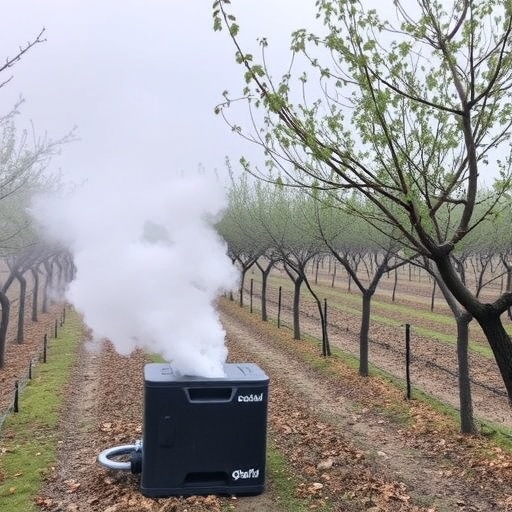In the ever-evolving world of agricultural technology, a groundbreaking initiative has emerged that promises to change the landscape of frost prevention in mountain orchards. Researchers have unveiled a novel anti-frost smoke machine system designed specifically for mountainous terrains, employing a sophisticated multi-objective optimization framework. This innovative system has the potential to revolutionize how orchardists protect their crops from the damaging effects of late spring frosts, a common challenge faced by farmers in higher elevations.
Farming in mountainous regions comes with a unique set of challenges, with frost being one of the most detrimental threats to crops. The occurrence of frost can devastate fruit orchards, leading to significant financial losses for farmers. Thus, ensuring the protection of crops through effective frost prevention strategies is critical. The recent research released in Science Reports outlines a pioneering solution aimed at mitigating this risk through smoke generation, which, when properly deployed, can create a protective layer that insulates crops from cold air.
The crux of the research lies in the design and engineering of the smoke machine itself. Researchers have meticulously crafted the system to generate smoke at predetermined intervals and densities, tailored to the specific microclimates prevalent in mountainous orchard environments. By utilizing multi-objective optimization techniques, the team was able to calibrate the machine’s performance to maximize efficacy while minimizing fuel consumption and operational costs. This dual focus not only enhances the machine’s functionality but also makes it economically viable for farmers.
The technical aspects of the smoke generation process are characterized by a carefully controlled combustion process. The smoke is generated through the burning of specific materials, chosen for their efficiency in producing dense white smoke ideal for frost prevention. This aspect is critical, as the type of smoke produced can significantly influence its effectiveness in trapping heat and protecting crops. The researchers found that utilizing a mixture of biomass and agricultural waste products yielded the best results, creating a sustainable and environmentally friendly approach to frost management.
Operationally, the machine’s design incorporates advanced sensing technology that monitors environmental conditions in real-time. Temperature, humidity, and wind speed are continuously assessed, allowing the machine to adjust its smoke output accordingly. Such adaptability is crucial, as issues such as unexpected temperature drops or changes in wind direction can impact the effectiveness of frost prevention efforts. The ability to respond quickly to fluctuating conditions could be the difference between protecting yield and suffering extensive crop losses.
The research team conducted extensive field tests to validate the efficiency of this innovative smoke machine system. Trials carried out in various mountain orchard settings demonstrated significant reductions in frost damage compared to control plots, where no smoke protection was applied. The effectiveness of the smoke barrier was measured through several key indicators, including fruit yield and qualitative assessments of fruit quality. The results were promising, marking this system as a revolutionary step in orchard management practices.
Environmental sustainability is a pivotal theme within modern agricultural research, and this new system aligns well with that ethos. By leveraging waste materials and optimizing fuel usage, the smoke machine presents a green alternative to traditional frost prevention methods, which often rely on gas-operated heaters or other high-emission technologies. This emphasis on sustainability resonates with a growing global initiative to reduce the carbon footprint of agriculture while maintaining productivity and profitability.
The implications of this research extend beyond the immediate benefits of frost protection. Implementing effective anti-frost measures can have lasting effects on regional economies reliant on fruit farming. With the capacity to prevent frost-induced crop failures, farmers can maintain steady income streams and contribute to local food security, which becomes increasingly crucial as climate impacts fluctuate throughout the seasons.
Community engagement plays a vital role in the adoption of such technologies. The research team has emphasized the importance of collaboration with local farmers during the development and implementation stages. Workshops and demonstrations are being organized to educate orchardists about the functionality of the smoke machine and best practices for its operation. This knowledge transfer is essential to ensure that farmers can effectively integrate the machine into their frost management strategies.
In conclusion, the development of the anti-frost smoke machine for mountainous orchards represents a significant advancement in agricultural technology. By focusing on multi-objective optimization, the research successfully marries efficiency with sustainability, providing a robust solution to one of the industry’s most pressing challenges. As research continues to evolve, the hope is that innovations like this will pave the way for a more resilient agricultural future, equipped to handle the unpredictable pressures of climate change and ensure food production remains viable in all regions.
With the growing concern over climate change and its impact on agriculture, the introduction of solutions like the anti-frost smoke machine is more important than ever. Researchers are optimistic that this initiative will spark further innovations in farm technology, creating even more sophisticated systems to tackle a range of environmental challenges faced by farmers worldwide. The future of agriculture may indeed rest on such inventive strides, enabling the industry to thrive despite emerging threats and enhancing the capability of farmers to produce food sustainably.
Subject of Research: Anti-frost smoke machine system for mountain orchards
Article Title: Design of anti-frost smoke machine system for mountain orchard based on multi-objective optimization
Article References:
Lu, Y., Zhang, W., Lin, Y. et al. Design of anti-frost smoke machine system for mountain orchard based on multi-objective optimization.
Sci Rep 15, 40681 (2025). https://doi.org/10.1038/s41598-025-21322-w
Image Credits: AI Generated
DOI: https://doi.org/10.1038/s41598-025-21322-w
Keywords: Anti-frost technology, mountain orchards, multi-objective optimization, agricultural sustainability, frost prevention solutions.
Tags: agricultural technology advancementsanti-frost technology for orchardschallenges of farming in mountainous regionsengineered solutions for crop insulationfinancial implications of frost damage in farminginnovative frost prevention systemslate spring frost impact on fruit orchardsmountain orchard crop protection strategiesmulti-objective optimization in agriculturesmoke generation techniques for frost protectionsmoke machine optimization for frost preventiontailored agricultural solutions for microclimates





